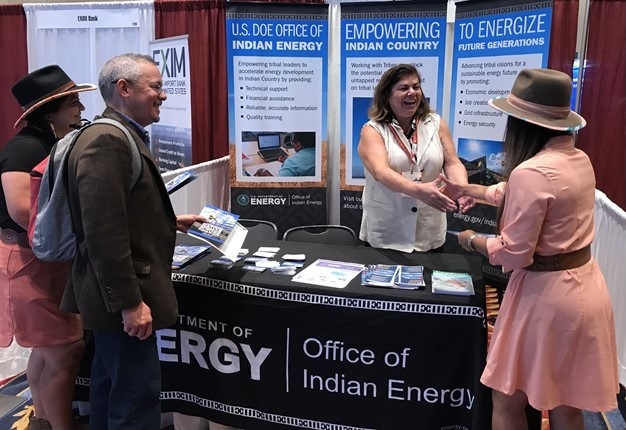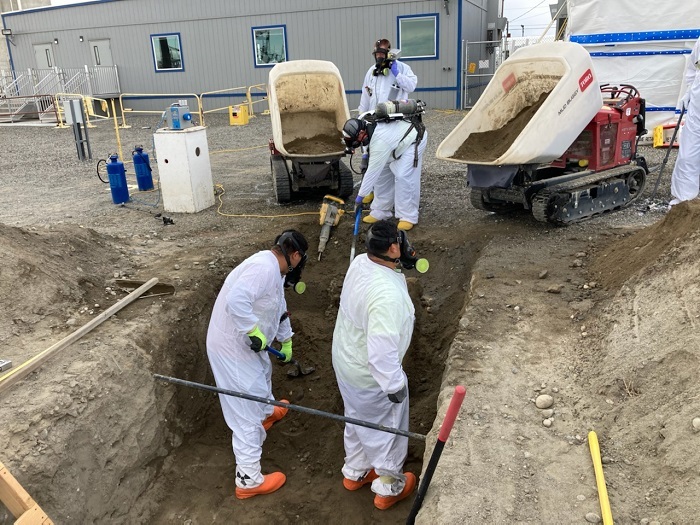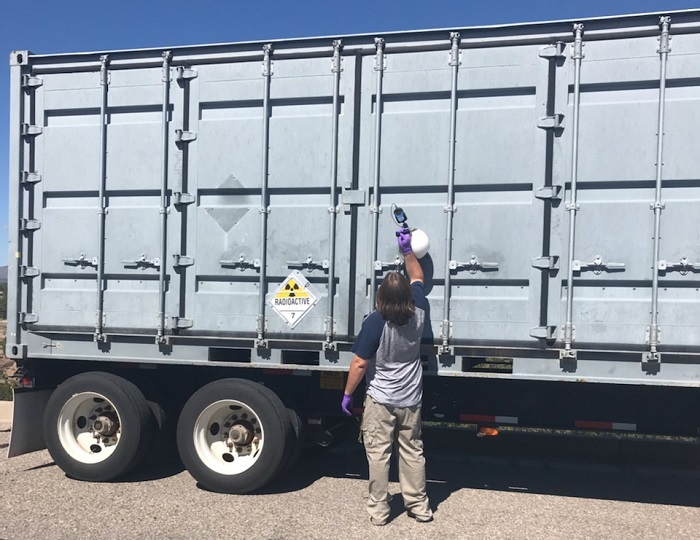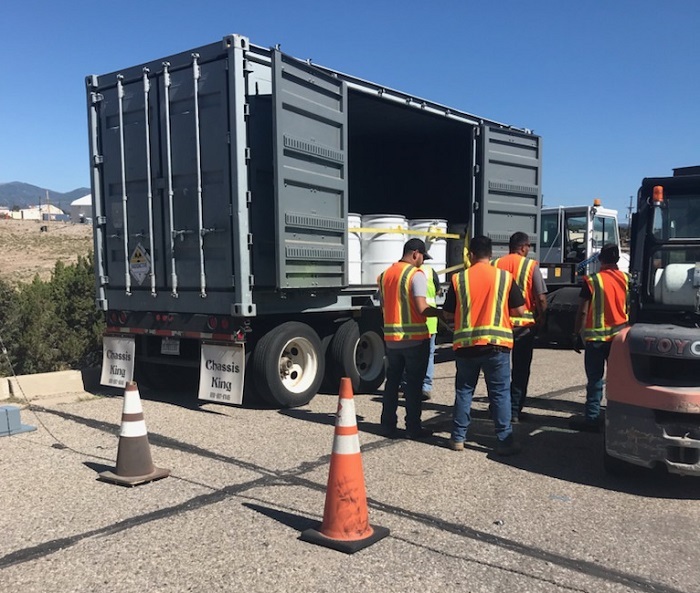 EM Tribal Affairs Program Manager Jill Conrad shakes hands with Stacia Greene, a Nez Perce tribal small business owner, and greets other Reservation Economic Summit 2021 attendees.
LAS VEGAS – EM officials met with representatives of tribal-owned businesses and Alaska Native corporations to discuss how they can support the cleanup program during the recent Reservation Economic Summit (RES) 2021.
EM Small Business Program Manager Anne Marie Bird highlighted subcontracting as a way to enhance opportunities for small businesses. She also stressed the importance of pre-solicitation and pre-proposal conferences as key networking avenues.
Bird noted the importance of EM’s collaborations with Indian Country businesses, as several of EM’s cleanup sites are located near sovereign tribal nations and impact Indian lands and resources. She also highlighted potential contracting opportunities for those Indian Country businesses.
“Contracts with these businesses allow EM to tap into unique tribal expertise,” Bird said. “RES provides an unparalleled platform to unite native-owned businesses with EM.”
Marking its 52nd year, RES is sponsored by the National Center for American Indian Enterprise Development. The summit brings together tribal leaders, members of Congress, federal agency representatives, state and local officials, and CEOs.
“RES is the best venue for engaging with tribal businesses who are interested in working with DOE,” EM Tribal Affairs Program Manager Jill Conrad said. “We see businesses we might not otherwise be aware of and can talk with them about opportunities and the federal contracting process.”
-Contributors: Demitrous Blount, Jill Conrad
 A shipment of transuranic waste approaches EM’s Waste Isolation Pilot Plant (WIPP) on the WIPP North Access Road. To date, almost 13,000 shipments have been safely transported to WIPP, and its drivers have traveled more than 15 million safe loaded miles.
CARLSBAD, N.M. – EM’s Waste Isolation Pilot Plant (WIPP) is not only back, it’s back with an exclamation mark.
Shipments to the nation’s only deep underground repository for defense-related transuranic (TRU) waste slowed to five per week during the height of the COVID-19 pandemic, half the rate prior to the pandemic.
But this summer, WIPP began to ramp back up, receiving 12 shipments in one week last month. The goal is to average at least 10 shipments per week for the foreseeable future. Within two years, the target is 17 shipments per week, reducing the backlog of waste at generator sites such as the Los Alamos and Idaho national laboratory sites, Oak Ridge, and the Savannah River Site (SRS).
In addition, on July 22, WIPP received shipments from four different generator sites, including the Los Alamos and Idaho national laboratory sites, Oak Ridge, and SRS. This is the first time WIPP has achieved this milestone since 2013.
"As EM sites continue to make substantial progress in their cleanup missions, WIPP looks forward to continuing to safely accept these shipments and properly dispose of the waste," said Mark Bollinger, deputy manager of EM’s Carlsbad Field Office, which oversees WIPP. Bollinger added, however, that the surge in the delta variant remains a concern and adhering to COVID-19 safety protocols is paramount.
Shipments of TRU waste to WIPP started in 1999, and through July 21, it has received 12,942 shipments. Waste emplaced 2,150 feet beneath the surface is at 40% of the 6.2-million-cubic-feet capacity allowed under the WIPP Land Withdrawal Act.
TRU waste consists of tools, rags, protective clothing, sludges, soil, and other materials contaminated with radioactive elements. These manmade elements have atomic numbers greater than uranium on the periodic table of elements, thus “trans-uranic” or beyond uranium.
WIPP has received 179 shipments so far in fiscal 2021, which ends Sept. 30.
The facility received 292 shipments in calendar year 2019 before slipping to 192 shipments in calendar year 2020 due to COVID-19 restrictions.
Drivers for WIPP are among the best on the road, meeting stringent qualifications to become part of the operation. They work for CAST Specialty Transportation, the company contracted to transport all TRU waste shipments to WIPP. Their two-person teams drive from generator sites to the WIPP facility, stopping only for safety inspections, food, and fuel.
The trucks are tracked by satellite via the Transportation Tracking and Communication System (TRANSCOM) and have designated safe parking areas on approved routes for use during inclement weather or emergencies. As part of the shipping protocols agreed to by DOE, state and tribal officials are notified by TRANSCOM two hours prior to a WIPP shipment entering their state.
As of June 30, WIPP drivers have safely driven 15,464,471 miles, the equivalent of 32 roundtrips to the moon.
-Contributor: Roy Neese
 Crews with Savannah River Remediation install four new ion-exchange columns into the Tank Closure Cesium Removal unit at the Savannah River Site.
AIKEN, S.C. – EM and its liquid waste contractor at the Savannah River Site (SRS) continue to make progress on a waste treatment demonstration project with the installation of new ion-exchange columns.
Savannah River Remediation (SRR) recently installed four new ion-exchange columns into the Tank Closure Cesium Removal (TCCR) process unit.
A pilot demonstration helping accelerate tank closure at SRS, TCCR selectively removes radioactive cesium from salt waste in Tank 10 in H Tank Farm. The four ion-exchange columns hold a specially engineered resin called crystalline silicotitanate. Salt waste is processed through these ion-exchange columns to remove the radioactive cesium. The resulting decontaminated salt solution stream is sent to Tank 11 and eventually to the Saltstone Production Facility for on-site disposal in Saltstone Disposal Units.
Installing the new columns is one of many tasks preparing for TCCR operations to resume this summer. In parallel, salt waste is being prepared in Tank 9 for transfer to Tank 10, the feed tank for TCCR. Decontaminating salt waste through TCCR supplements the decontaminated salt solution produced by Salt Waste Processing Facility operations.
The new columns are the second set of four to be used in TCCR. The original columns were filled with the cesium collected from Tank 10 and removed from the unit in December 2020.
TCCR has decontaminated nearly 300,000 gallons of salt waste since operations began in January 2019.
DOE-Savannah River Assistant Manager for Waste Disposition Jim Folk said the TCCR project helps bring Tank 10 closer to operational closure.
“Operational waste tank closure at the Savannah River Site is part of EM’s vision that will protect the public and environment,” Folk said. “Tank Closure Cesium Removal is accelerating that vision by supplementing salt waste processing at SRS in support of tank closure.”
SRR President and Project Manager Phil Breidenbach said TCCR has modernized and advanced salt processing.
“The Tank Closure Cesium Removal system is built on the experience of commercial nuclear plant decontamination technology,” Breidenbach said. “This innovative technology, including the recently installed new ion-exchange columns, is another tool that will allow Savannah River Remediation to continue removing and treating waste leading to the ultimate end state of closed waste tanks.”
-Contributor: Colleen Hart
 Hanford tank farms workers are monitored for heart rate and body temperature during high-heat conditions.
RICHLAND, Wash. – EM’s Hanford Office of River Protection tank operations contractor Washington River Protection Solutions (WRPS) has a multilayered, nationally recognized approach to keeping workers safe during the hot summer months.
Physiological monitoring is a key component of ensuring the safety of those working outdoors who often wear multiple layers of personal protective equipment.
“Traditional heat stress controls are implemented through monitoring of meteorological data,” said Larry Yearsley, an industrial hygienist with Hanford’s Industrial Hygiene Safety & Health Division. "The addition of physiological monitoring allows for a more individualized approach to employee safety and health and is another example of the site’s commitment to DOE’s Voluntary Protection Program.”
Working through cooperative efforts among labor, management, and government at DOE contractor sites, the Voluntary Protection Program promotes improved safety and health performance through public recognition of outstanding programs.
In physiological monitoring, a wireless heart rate monitor provides remote, real-time assessment of heat strain and core body temperature of employees. This gives workers an early indication they may be at risk of a heat-related issue.
WRPS won a prestigious Campbell Innovation Challenge award in 2017 for its groundbreaking physiological monitoring program.
“This program implemented an innovative solution to an environmental challenge that identified the worker physiological experience. Before the physiological monitoring program, we used meteorological and instrument monitoring, measuring ambient temperature, humidity, and wind speed to identify heat stress situations,” said Jeremy Hartley, WRPS environment, safety, health, and quality manager. “The importance of being able to reduce heat stress disorders for the safety of our workers is a great benefit.”
Other heat mitigation controls include cooling tents that provide shade, water misters, and a place to rest and remove protective equipment to hydrate. In addition to an extensive heat stress prevention communications campaign, using early morning shifts reduces worker exposure to hot, daytime weather.
-Contributor: Denise Mellene
 A worker with Newport News Nuclear BWXT-Los Alamos, the cleanup contractor for the EM Los Alamos Field Office (EM-LA), surveys EM-LA's 30th transuranic waste shipment of fiscal 2021 in Area G at Technical Area 54 for on-site loading at the Radioassay and Nondestructive Testing facility at Los Alamos National Laboratory.
LOS ALAMOS, N.M. – The EM Los Alamos Field Office (EM-LA) and cleanup contractor Newport News Nuclear BWXT-Los Alamos (N3B) recently completed their 30th shipment of transuranic (TRU) waste for the fiscal year that began in October last year.
“We are excited with the progress our team has made to move waste out of Los Alamos,” said Ellen Gammon, N3B waste and engineering manager. “Making the thirtieth shipment this fiscal year demonstrates the strong progress we have made toward cleaning up legacy waste at Los Alamos.”
EM-LA increased efficiency in waste shipments after N3B and Triad, contractor to the National Nuclear Security Administration (NNSA) at Los Alamos National Laboratory (LANL), began combining TRU waste shipments for disposal at EM’s Waste Isolation Pilot Plant (WIPP). By comingling waste shipments, EM and NNSA can ship legacy and new-generation radioactive waste together, maximizing resources while safely transporting waste for off-site disposal. The EM and NNSA Los Alamos field offices completed their first comingled shipment of TRU waste in January.
 A crew with Newport News Nuclear BWXT-Los Alamos, the cleanup contractor for the EM Los Alamos Field Office (EM-LA), prepares EM-LA's 30th transuranic waste shipment of fiscal 2021 in Area G at Technical Area 54 for on-site loading at the Radioassay and Nondestructive Testing facility at Los Alamos National Laboratory.
NNSA and Triad operate the Radioassay and Nondestructive Testing (RANT) facility at LANL. The facility provides space for EM crews to load drums, boxes, and 10-drum overpacks containing TRU waste into shipping containers. Workers confirm the containers meet WIPP’s waste acceptance criteria under a program approved by the State of New Mexico and the U.S. Environmental Protection Agency before they are shipped to the waste repository.
N3B has sent 51 shipments of TRU waste to WIPP since the start of its Los Alamos legacy cleanup contract in 2018, representing over 279 cubic meters of waste prepared and removed offsite.
-Contributor: Estevan Lujan
|